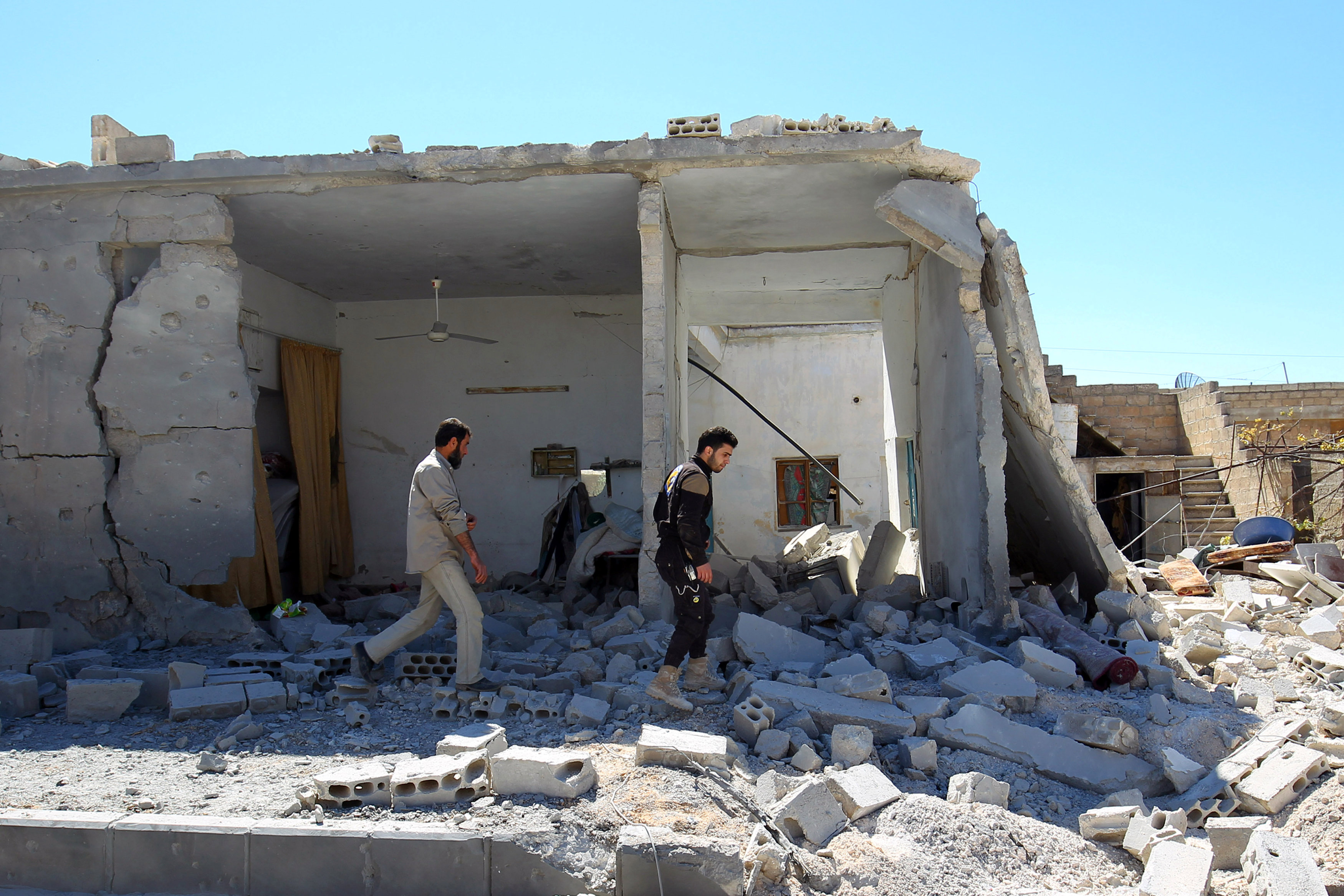Image: Civil defense members inspect the damage at a site hit by airstrikes on Tuesday, in the town of Khan Sheikhoun in rebel-held Idlib, Syria April 5, 2017. REUTERS/Ammar Abdullah
![]()
By Ellen Francis and Tom Perry
BEIRUT (Reuters) – The Syrian army jet that hit the town of Khan Sheikhoun at dawn dropped three conventional bombs and a fourth one that made little sound at impact but produced a cloud of white smoke, according to an activist observing from a nearby hilltop.
Hussam Salloum, a volunteer with an air raid warning service in rebel-held areas, said the Sukhoi-22 that attacked on Tuesday approached at low altitude, leaving behind three columns of dark smoke and the white cloud nearer to ground level.
“The smoke was white and thick,” he told Reuters from Khan Sheikhoun. “The smoke began to spread out across the town, until there was a layer over the town,” he said, sending a video filmed from an observation point that showed the plumes of smoke.
The Syrian government has strongly denied launching a chemical attack on the town. While Western states have accused Damascus, the Syrian government’s Russian allies say the deaths were the result of a Syrian air strike on a rebel arms depot where chemical weapons were being produced. Rebels deny this.
At least 70 people, many of them children, were killed by what two U.S. government sources say was sarin gas, in the deadliest chemical attack in Syria since the same nerve agent killed hundreds of people in a rebel-held area near Damascus in 2013.
Medicins Sans Frontieres said eight people it treated had symptoms consistent with nerve agents like sarin. The medical charity said it had also been to hospitals where it had noted a strong smell of chlorine, another toxic agent.
The World Health Organization said victims appeared to show symptoms consistent with exposure to organophosphorus chemicals. Sarin is an organophosporus compound, while chlorine is not.
Some of the dead, including children, showed no visible injuries, indicating the gas had killed them in their beds, said Mouin Abed al-Menem, a doctor who treated several victims.
Rescue workers found the bodies of a woman and two children on Wednesday in a cave where they had been sheltering, according to the civil defence emergency service that operates in rebel-held areas.
“The pilot carried out the bombing in one go, four bombs together,” said Salloum, who said he observed the raid from about 1.5 km (one mile) away and used walkie-talkies to alert rescue workers.
The service he works for includes a network of volunteers who track aircraft movements and radio traffic in order to warn of potential air strikes, Salloum said.
“We discovered it was toxic gas from a civil defence worker who went to the place quickly,” he added. “He told us there was an unusual smell. Less than a minute later, he told us he was dizzy and fainting. We lost contact with him.”
Twenty of the dead were children, the British-based Syrian Observatory for Human Rights said.
The explosions woke up civil defence worker Khaled al-Nasr just after 6:30 a.m. (0330 GMT). He arrived at the scene to find several of his colleagues suffering from the effects of the gas.
“I COULDN’T BREATHE”
“We saw everyone was on the ground. People were squirming. Some had foam coming out of their mouths. We started picking people up,” Nasr said. Shortly after arriving, he too felt a burning sensation in his eyes but kept working until he was unable to continue. “I couldn’t breathe,” he said.
Rescue workers undressed victims and doused them with water. “Immediately, apply water, then get them out,” he said.
The victims were sent to hospitals and facilities around Idlib, including a medical position next to a civil defence operating centre near the town. An air strike hit that medical position later in the morning, the civil defence and the Observatory said.
Some victims were also sent across the border to Turkey for treatment.
“There was a rocket, a rocket explosion that had a lot of smoke coming out of it,” said one of the victims, speaking to Reuters TV at a hospital in Turkey.
“There was a lot of smoke and there was a smell, it was very difficult to breath,” she said. A second victim said he fell to the ground as the gas took effect.
A crater that rescue workers identified as the site of the chemical strike was about 1 metre in diameter. The surrounding ground appeared scorched, a Reuters photo showed.
Khan Sheikhoun was largely deserted on Wednesday. The casualty toll continues to rise.
Menem, the doctor in Idlib, said the medical facility where he works received 68 of the victims, 21 of them dead.
“Almost two thirds were children. Some of them were alive at the site of strike, but died on the way,” he told Reuters. “Most had foam around their mouths, agitation and constricted pupils.”
“We treated them with available medicine, mostly with cortisone,” he added.
“We are still getting patients. Today we also admitted around 18 people, from areas a bit further from the site of the strike, in addition to two rescue workers,” Menem said. “They were impacted 24 hours later.”
(Writing by Tom Perry; editing by Giles Elgood)
Copyright 2017 Thomson Reuters. Click for Restrictions.


